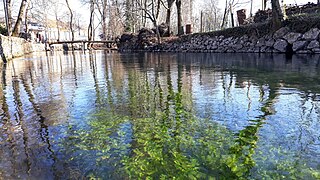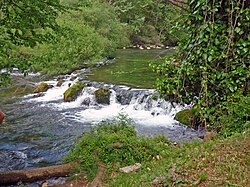
Split-Dalmatia County is a central-southern Dalmatian county in Croatia. The administrative center is Split. The population of the county is 455,242 (2011). The land area is 4.540 km2, the total area is 14.106,40 km2. Split-Dalmatia County is Croatia's most rapidly urbanising and developing region, as economic opportunities and living standards are among the highest alongside capital Zagreb and Istria County.

Salona was an ancient city and the capital of the Roman province of Dalmatia. It was the last residence of the final western Roman Emperor Julius Nepos and acted as the de facto capital of the Western Roman Empire during the years 476-480. Salona is located in the modern town of Solin, next to Split, in Croatia.

Solin is a town and a suburb of Split, in Split-Dalmatia county, Croatia. It is situated right northeast of Split, on the Adriatic Sea and the river Jadro.

The Neretva, also known as Narenta, is one of the largest rivers of the eastern part of the Adriatic basin. Four hydroelectric power plants with large dams provide flood protection, electricity and water storage. The Neretva is recognized for its natural environment and diverse landscapes.

Salmo is a genus of ray-finned fish from the subfamily Salmoninae of family Salmonidae, and is part of the tribe Salmonini along with the sister genera Salvelinus and Salvethymus. Almost all Salmo species are native only in the Old World, the only exception being the Atlantic salmon, which is also naturally found across the North Atlantic in eastern North America.

Kaštela is a town and a suburb of Split, in Split-Dalmatia County, Croatia. The town is an agglomeration of seven individual settlements which are administered as a single municipality with populations individually ranging from 3,000 to 7,000 residents. The town is located northwest of the city of Split, west of Solin and east of Trogir, on the central Dalmatian coast. With a total population of 37,794 as of 2021 census, it is the 14th largest town in the country.
Salmo obtusirostris salonitana is an endemic trout subspecies found in the Jadro River in the vicinity of Solin, and in the nearby Žrnovnica River, where it was introduced in 1964. The upper reaches of the Jadro River including Jadro Spring, covering an area of 7.8 hectares, have been protected as an ichthyological reserve since 1984, for the purpose of preserving this endangered fish species, S. o. salonitana.

Salmo obtusirostris, commonly known as the softmouth trout, also known as the Adriatic trout, or Adriatic salmon, is a species of salmonid fish endemic to a handful rivers spilling into Adriatic in the Western Balkans, in southeastern Europe, namely in Bosnia and Herzegovina, Croatia and Montenegro. The scientific name has changed several times through history; synonyms include Thymallus microlepis, Salmothymus obtusirostris and Salar obtusirostris.

Saint Domnius was a Bishop of Salona around the year 300, and is venerated as the patron of the nearby city of Split in modern Croatia.
The Jadro Spring is a water source rising in the Dinaric Alps in Croatia. The spring was the original water supply for the ancient city comprised by Diocletian's Palace. Contemporary studies indicate favourable water quality levels at the spring source. The Jadro Spring is the source of the Jadro River. A rare species found in the upper reach of the Jadro River is the soft-mouthed trout, Salmothymus obtusirostris salonitana.

Kaštel Sućurac is a town within the administrative area of Kaštela in Dalmatia, Croatia. Kaštel Sućurac is first of its 7 kastels from East. Patron saint of the town is Saint George.

Split, historically known as Spalato, is the second-largest city of Croatia, after the capital Zagreb, the largest city in Dalmatia and the largest city on the Croatian coast. It lies on the eastern shore of the Adriatic Sea and is spread over a central peninsula and its surroundings. An intraregional transport hub and popular tourist destination, the city is linked to the Adriatic islands and the Apennine Peninsula. More than 900,000 tourists visit it each year.

Konjic is a city located in the Herzegovina-Neretva Canton of the Federation of Bosnia and Herzegovina, one of two entities that make up Bosnia and Herzegovina. It is located in northern Herzegovina, around 60 kilometres (37 mi) southwest of Sarajevo, in a mountainous, heavily wooded area, and is 268 m (879 ft) above sea level. The municipality extends on both sides of the Neretva River. According to the 2013 census, the city of Konjic has a population of 10,732 inhabitants, whereas the municipality has 25,148.

The Cathedral of Saint Domnius, known locally as the Sveti Dujam or colloquially Sveti Duje, is the Catholic cathedral in Split, Croatia. The cathedral is the seat of the Archdiocese of Split-Makarska, currently headed by Archbishop Zdenko Križić. The Cathedral of St. Domnius is a complex of a church, formed from an Imperial Roman mausoleum, with a bell tower; strictly the church is dedicated to the Virgin Mary, and the bell tower to Saint Domnius. Together they form the Cathedral of St. Domnius.

Čikola is a river of in Dalmatia, southern Croatia.

Upper Neretva, is the upper course of the Neretva river, including vast mountainous area surrounding the Neretva, with numerous human settlements, peaks and forests, numerous streams and well-springs, three major glacial lakes near the river and even more scattered across the mountains of Treskavica and Zelengora, in a wider area of the Upper Neretva with its flora and fauna.

The Aqueduct of Diocletian is an ancient Roman aqueduct near Split, Croatia constructed during the Roman Empire to supply water to the palace of the emperor Diocletian, who was Augustus 284 to 305 AD, retired to Spalatum, and died there in 311.
The fish fauna of the Neretva river basin in the western Balkans is representative of the Dinaric karst region and characterized by several endemic and endangered species.

The Vrljika is short sinking river in Croatia and Bosnia and Herzegovina, belonging to Neretva River basin. Its source is located on the outskirts of village Proložac near town of Imotski, Croatia. The Vrljika River is home of endangered endemic Softmouth trout, also known as Adriatic trout.

Žrnovnica is a river in Croatia that springs at the foot of the Mosor, near Dvori village, in Split municipality, and in its short course flows through Žrnovnica and Podstrana settlements, in the wider area of city of Split, in the Split-Dalmatia County. The total length of the river is 4,800 meters. Its basin is a direct Adriatic Sea watershed.




















